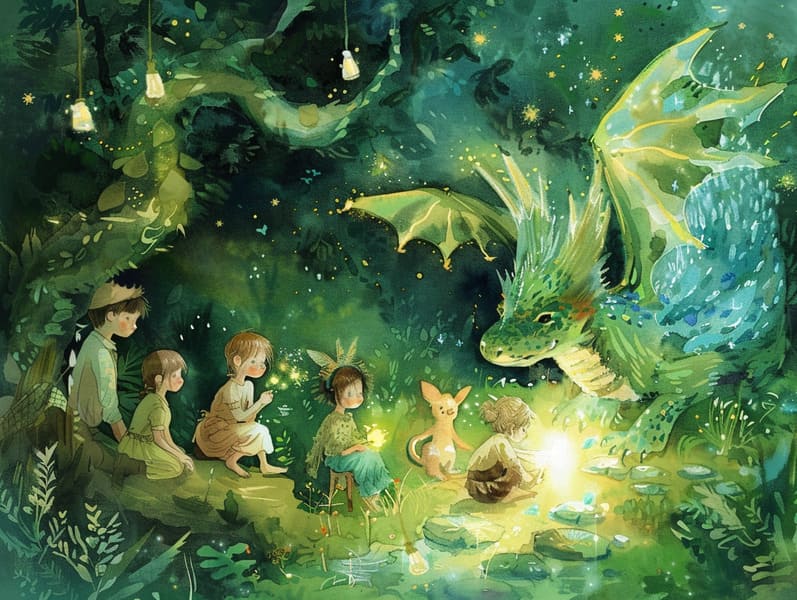The Inception of Fairy Tales for Kids and the Unchanging Radiance.
The Inception of Fairy Tales for Kids and the Unchanging Radiance.
Blog Article

Fairy tales have enduring presence. These narratives have been relayed from one generation to the next ages before they were ever put on paper. They arose from a variety of backgrounds, including African traditions. They were initially conveyed among elders, often carrying themes and messages mirroring the societal norms and beliefs of the time.
Jacob and Wilhelm Grimm, Jacob and Wilhelm Grimm, were among the first to gather and publish many of these beloved stories. Their published works, "Grimm's Fables," included classics like "The True Bride," "The Story of Hansel and Gretel," and "Schneewittchen," which have since become mainstays in the world of famous fairy tales. Similarly, Hans Christian Andersen's delightful tales, such as "The Story of the Little Mermaid," and "The Duckling's Story," have gained the love worldwide, cementing their place in the pantheon of beloved fairy tales.
Despite their historical roots, these stories remain as applicable as ever, especially as kids' bedtime tales. These fantastical tales are now available in various formats, including beautifully illustrated books, captivating animations, and internet fairy tales.
Their unwavering allure can be traced to several fascinating points:
Crucial Morals: Traditional fairy tales often provide important moral lessons. Narratives like "The Boy Who Cried Wolf" teach the significance of being truthful, while "The Story of the Tortoise and the Hare" demonstrate the qualities of resolve and meekness. These tales offer young readers clear distinctions between ethical and unethical, helping to shape their moral compass in a gentle yet significant way.
Sympathy and Perception: Ancient fairy tales frequently include heroes facing struggles and tests, motivating readers to resonate with their struggles and support their triumphs. For instance, "Beauty and the Beast" illustrates the merit of seeing inner beauty to understand the inner spirit of a character, building perception and comprehension.
Cultural Appreciation: Many traditional fairy tales are rooted in the cultural contexts from which they were born. Exploring these narratives can provide illuminating insights into different beliefs, enhancing a sense of global respect and acknowledgment.
Inventiveness and Imagination: The mythical elements in ancient fairy tales—enchanted lands—awaken children’s imaginative ideas. These stories lead readers to magical realms, unleashing imaginative thinking and a sense of astonishment that persists a lifetime.
Classic fairy tales are not only charming but also illuminating. They function as entrancing tools in enhancing various thinking and feeling skills in children. When fairy tales are recited, they strengthen language acquisition by introducing new terms and detailed sentence structures. This practice also boosts hearing perception and concentration, as children hang on every word, anxious to see what happens next.
Furthermore, analyzing the themes and characters of fairy tales can enhance thought processes and problem-solving abilities. Kids are educated to identify patterns, expect results, and make sense of cause and effect. These debates also contribute to young ones express their thoughts and feelings, strengthening their emotional intelligence.
In today’s information age, the availability of internet fairy tales has made these narratives more within reach than ever. Web-based platforms and applications supply comprehensive collections of Grimm's fairy tales that can be viewed or listened to anytime, anywhere. Fairy tales recited are particularly popular, offering an captivating way for young readers to take part in these whimsical stories. Audiobooks and read-aloud videos move characters and settings to life, often enhanced by fantastical musical scores and music that improve the story adventure.
The timeless allure of this site timeless fairy tales lies in their ability to adapt to new eras while holding onto their underlying messages. Contemporary reinterpretations of these stories often spotlight more multicultural characters and modern settings, making them relevant to today’s audience. However, the main ideas of bravery, charity, and rightness remain unchanged, continuing to reach kids of all ages.
Timeless fairy tales also offer a sense of protection and knowability. They render accessible a orderly narrative with a recognizable beginning, middle, and end, often concluding with the solving of conflicts and the triumph of goodness over badness. This reliability can be calming for young readers, showcasing a sense of unwaveringness in an shifting world.
Old fairy tales continue to captivate and teach new generations, maintaining their charm and importance in modern society. As children's bedtime stories, they present to a perfect blend of delight and instruction, nourishing moral values, empathy, and creativity. The availability of free fairy tales online and the popularity of fairy tales read out loud promise that these old stories remain acquirable to new generations.
By holding onto and relating these tales, we continue to honor the rich tapestry of storytelling and cultural heritage. Whether you are discovering a vibrantly illustrated book, delving into a virtual collection, or listening on an audiobook, the loveliness of classic fairy tales is always within reach. These stories convey of the unceasing force of stories and its ability to unify us across centuries and lands.
No matter if you are perusing a vividly illustrated book, enjoying a electronic library, or hearing an narrated book, the allure of timeless fairy tales is always within reach.
These stories point out of the continued strength of fairy tales and its ability to connect us across generations and cultures, forming a connection that captivates and teaches alike.